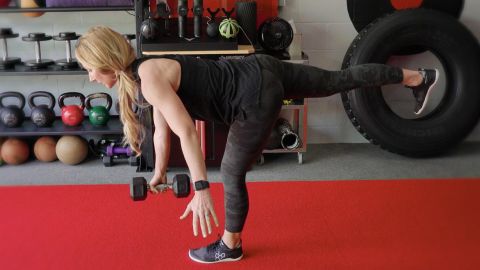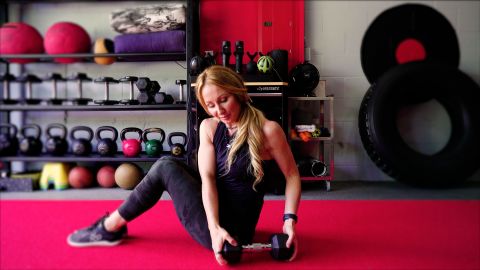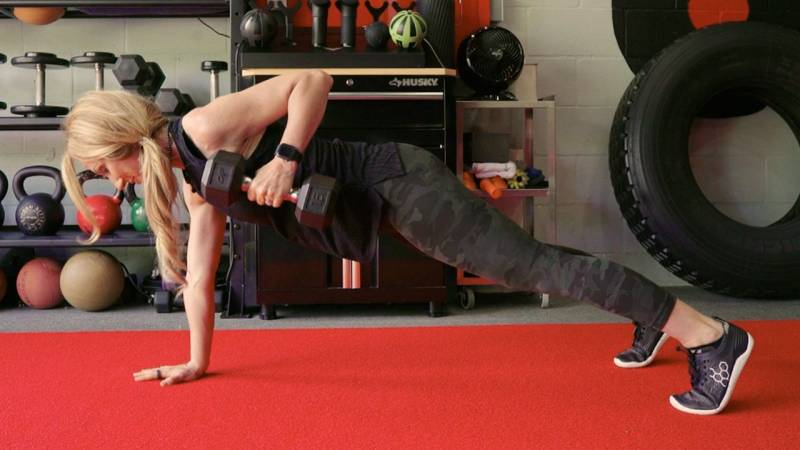When you think about working out with dumbbells, you probably picture using a set of two, one in each hand. There are many exercises you can do with two dumbbells, but as a strength and conditioning coach, I can tell you there are just as many — if not more — you can do using just one. In fact, you can effectively train your entire body using a single dumbbell in about 10 minutes. Below, I’ve outlined five exercises you can do sequentially to strengthen your legs, hips, arms, shoulders, and core. Read the detailed descriptions for each exercise to familiarize yourself with the cues and any needed modifications, then follow along with me in the video above as I take you through each exercise.
Preparing to work out
It’s important to pick a weight that’s manageable for you to do all the exercise repetitions with good form. That means avoiding moving your body in ways that compensate for muscle fatigue or weakness in the area you are trying to work, such as doing a bicep curl while swaying your back as you curl the weight up with momentum from your back muscles.
Compensations can lead to injury, so you want to avoid that! For more on picking the right weight, If you’re new to working out or just returning after a break, be sure to ease back into it.
Important note: Before beginning any new exercise program, consult your doctor. Stop immediately if you experience pain.
Doing the 5 exercises
Perform eight to 10 repetitions of each exercise on each side of your body unless otherwise noted for exercises that don’t alternate sides. As you do the workout, try to breathe in through your nose and either out through your mouth or nose — whatever is most comfortable for you. Breathing in through your nose is going to provide the most oxygenation and enhance your endurance.
1. Goblet squat
Stand with your feet hip distance apart. Hold the dumbbell with both hands at chest level, with each hand cradling one end of the weight.
Angle your feet out slightly, opening your hips at an angle that is comfortable for you to squat.

Inhale and then hold the inhale as you squat down to a level where your hips align slightly below your knees (if that isn’t possible, see the modification below).
Exhale as you push through your feet and return to a standing position.
Try to keep your weight evenly distributed through your feet, legs and hips.
How to modify: If deep squatting is difficult, use a low chair or sturdy box as a base to squat down and gently sit on with each rep.
2. Balancing single-leg Romanian dead lift
Hold the dumbbell in your right hand at your side while you stand on your left leg.
Inhale and then hold the inhale as you hinge from your hips to bend over halfway while extending your right leg behind you so that your chest and back leg create a long line parallel to the floor.

Keep a soft bend in both legs if the back of your leg is too tight to straighten either or both legs.
Stabilizing with your standing leg, exhale as you use your hips and core to bring your body back to an upright standing position. Repeat on the opposite side.
How to modify: If the back of your leg is too tight to straighten either or both legs, keep a soft bend in both legs. To help with balance, you can perform these without weight while holding the side of a wall.
3. Plank with alternating row
Take a plank position with your feet a little wider than hip distance apart to help counterbalance the weight and movement when you lift the dumbbell to make a rowing movement in one arm. Hold the dumbbell on the floor with your right hand. Exhale as you lift the weight by bending your elbow and hugging it against your rib cage in a rowing motion. Inhale as you straighten your arm and return the weight to the floor while still holding it in your hand.

Keep your feet a little wider than hip distance apart to help counterbalance the weight and movement when you lift the dumbbell.
Stabilize through your core to avoid arching your low back. Repeat the reps on the right side before switching to the left side.
How to modify: Perform this exercise from a basic hands-and-knees position in which you’re on all fours.
4. Lateral lunge with overhead press
Stand with the dumbbell in your right hand, held up at shoulder height, lightly resting in your shoulder in what’s called a “racked” position. Place your left hand on your hip and step your left leg out laterally to the left, with your left leg bent like a half squat and your right leg straight. Both feet continue to point straight forward as you push off your left leg and step back into a standing position. Then press the dumbbell overhead and return it to the racked position at your shoulder.

Do all your reps on one side before switching the dumbbell to the opposite hand.
Each repetition takes two breaths: Inhale from standing, hold the inhale as you perform the lateral lunge, then exhale as you push back to standing. Inhale again in a standing position and then exhale as you push the weight overhead. Do all your reps on one side before switching the dumbbell to the opposite hand and lateral lunging on the opposite side.
How to modify: If the overhead press is too much, you can eliminate it.
5. Seated twist and tap
Sit on the floor with your knees bent, touching together, and your feet on the floor, also touching together. Hold the weight on each end, at your chest, like you did in the goblet squat exercise. Exhale and twist to the right, lowering your arms to touch the weight to the floor on the side of your body. Inhale and return to center, then exhale and repeat to the left side.

Try to keep your knees and feet together when doing the seated twist and tap.
Try to keep your knees squeezed together throughout the entire set of exercises to help stabilize your hips and core so that you are rotating from the middle of your back — not your low back. Because you’re alternating the movement side to side, instead of doing two sets of eight to 10 reps on each side, you’ll do one alternating set of 16 to 20 reps.
How to modify: If it’s too difficult to keep your knees together, squeeze a folded towel or yoga block between them. If your single dumbbell is too heavy for this exercise right now, don’t use it until you get stronger; instead, interlace your fingers in a double fist that you can tap to the floor as you rotate. Depending on your current fitness level and how these exercises feel, one round of this sequence should take you about eight to 12 minutes to complete. Never rush: Always focus on form. For best results, repeat this circuit two to three times per workout, two to three times per week.




